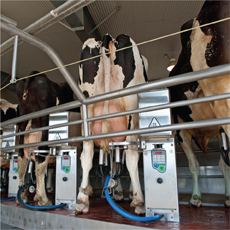Preventing Antibiotic Residues in Milk
Guidelines to help keep milk free of antibiotic residues.
Prevent disease to minimize the use of antibiotics:
- Maintain good herd health; use best management practices for animal husbandry.
- Diagnose sick animals early and accurately; take immediate action.
- Practice farm and herd biosecurity.
- Mark and separate treated cows from the milking herd.
Follow directions on drug and medicated feed labels:
- Note whether drug is approved for lactating cows.
- Follow instructions for treatment dosage, frequency and route of administration.
- Follow label directions for medicated feed, and never use feed intended for other livestock.
- Adhere to recommended milk-withholding time.
- If you treat cows “extra-label,” test all extra-label-treated cows before putting them back into the milking line.
- Withholding times for extra-label treatments are unknown.
- Test all dry-treated cows, especially those that freshen early, before putting them back into the milking line. Dry-cow treatments last longer.
Keep good treatment records:
- Make one person responsible for treating cows and monitoring records.
- Record the following:
- ID numbers of treated cows
- Dates and times of treatment
- The antibiotic used, its dosage, frequency and route of administration
- The drug withdrawal period
- Review and check records at every milking.
- Be informed of treatments given by your veterinarian.
Keep milk from treated cows out of the milking line:
- Withhold milk from any cow receiving oral, intramuscular, udder infusion or intrauterine antibiotic treatments and some salves and sprays.
- Segregate and test all purchased herd replacements before introducing them into the milking herd.
- Milk all treated animals last.
- Discard milk from all four quarters of udder, even if only one quarter was treated.

For information or to order:
Call IDEXX Technical Services, 1300 44 33 99.